
Center for Positive Futures: Shaping Social Responsibility in Secondary Education
por Pinky CASTELO CUPINO
Temas fortes ligados:
Educação e responsabilidade .
Temas largos ligados:
Crianças .
Educação .
Schools .
Youth .
Presentation by Fleur de Lys C. Cupino, during the “Learning for Life: Creating Endless Possibilities in Secondary Education” SEAMEO INNOTECH International Conference, November 16, 2006.
![]() Education affordable to those who have less
Education affordable to those who have less
![]() Education for the Economically Disadvantaged can be a Sustainable Enterprise
Education for the Economically Disadvantaged can be a Sustainable Enterprise
![]() Parent Enterprise Program
Parent Enterprise Program
![]() Quality Education
Quality Education
![]() School-Family Partnership
School-Family Partnership
![]() Vocational-Technical Skills Training
Vocational-Technical Skills Training
![]() Community Networking
Community Networking
![]() Education is a Social Development Responsibility
Education is a Social Development Responsibility
![]() Bibliography
Bibliography

- Community school with multiple intelligence strategy
Education affordable to those who have less
“I tried to save P40/day [1] from my daily earnings even if my husband is ‘only’ a security guard and I do odd work vending and the like. I did not even feel that it was a big burden to shell out P40 daily for tuition fee. Now the school year has ended. I was able to put our child to a year in a private school. I am happy because education is a lifetime investment, and it is all we could give to our child.” - Asuncion Agabin, parent
Center for Positive Futures is a parent-initiated school. It was organized in 2001 by a group of twenty parents. We were searching for an alternative and friendly education for our own children, who were then in their junior and senior years in secondary school. Sure, we wanted our children to receive good academic training. But more than that, we wanted them to be happy individuals enjoying their teen-age years, respected as individuals with their own intelligences. St. Joseph’s College of Quezon City [2] gave our children a home as our school became its research extension campus for alternative education.
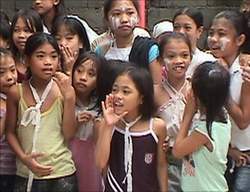
- Private and quality education should be affordable to those who have less
After graduating these twenty students who were our own children, we closed down operation in a high-end area of Quezon City to shift our educational focus to those who are economically disadvantaged. The school moved beyond addressing the needs of the parent-organizers towards meeting a social responsibility.
We believe that all Filipino children deserve quality education. We ourselves were pushed to the field of education by the need to respond to the plight of our own children. But the only way we wanted to continue to be involved in the education field was to provide access to quality education to those who would not ordinarily avail of the service of private schools because of financial handicap.
I had been fortunate to be able to afford the quality education that I dreamed my children to have. They received their formative education in non-traditional schools that developed their individuality, thirst for knowledge and creativity and for these I thank their schools – JASMS1, The Seed Montessori School and the Community of Learners Foundation [3]. We know there are a lot of other good schools committed to the holistic development of children and young people. But these are not affordable to those who have less.
On the other hand, I also know that there are big populations of parents who dream big for their children but who are constrained by economic challenges and hardship. For them, quality education in a private school is beyond their reach and their dreams.
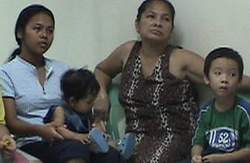
- These parents do not have the luxury of sending their kids to private school
This is not to say that the public school system is not doing its best to provide quality education. The Department of Education has been producing very good, well-researched curricula developed by specialists. It also regularly trains its teachers in integrated teaching methodologies. However, as we all know, the student population in the public schools is simply staggering compared to the available physical, material and manpower resources, thus negatively affecting the quality of education.
There is a need for private initiatives to complement the gap in the public school system – to provide education to those who can hardly afford, challenge their (the families’) priorities and/or how they utilize and stretch their income. The question that we faced was: what if this quality education became more accessible to those had less, would the economically disadvantaged respond to the challenge by sending their children to a private school?
We thought yes, they would.
We started to build schools in the poorer communities of San Mateo and Montalban where student population in the secondary level reached one hundred to a class – where there is a lack of chairs to sit students so that some have to sit in floors, where teachers can’t remember the names of each of her/his students by their sheer number, where the main challenge in lower sections is to maintain the students inside the classroom so that they wouldn’t crowd the hallway. Again, I would like to note that this is not a judgment on the administrative officials of the public high schools. In fact, the higher sections are conducted with fewer students (50) and if this is any indication, around 25 students per year pass the entrance exams in the University of the Philippines.
So in San Mateo and Montalban where the going tuition fee in private schools was fifteen thousand (P 15,000.00) to twenty two thousand (P 22,000.00) per school year, we offered secondary education at ten thousand (P 10,000.00) per year. To make our school more affordable, we developed a payment scheme wherein parents who earned monthly can pay monthly, parents who earned weekly can pay weekly and those who earned daily can pay daily. Daily payment means P40/day, less than a dollar a day. We also made the initial payment affordable so that paying the miscellaneous fee of one thousand five hundred (P 1,500.00) would be enough to enroll a student.
True, this may sound like big money to the poorest of the poor. But to those who earn daily like tricycle drivers and market vendors, or weekly like factory workers or monthly like lowly government employees, P40/day is affordable, especially if the family lives in the same community where the school is located. This makes economic sense considering that if parents send their child to the public school which is P 15/day away from where they live, they would just have to add another P 25 to the transportation cost that would be saved so that their child can enter a private school with a small classroom size, sans the security risk of traveling three kilometers to the public school. And what is P25/day to some families but the cost of one pack of cigarette or one big bottle of soft drinks.
Education for the Economically Disadvantaged can be a Sustainable Enterprise
We are now on our sixth year in the field of education and four years of providing education to the economically disadvantaged. We now have six schools – one in Montalban which already has an annex, two in San Mateo, one in Pateros, one in agricultural community in Sta. Rosa in Nueva Ecija and one in Puerto Princesa City in the island-province of Palawan.
The start-up is difficult, and in some of these schools, we are still in the start-up stage. Of course we started with a dream but we also had to start with some financing. We availed of a long-term loan from a bank using its acquired assets. Today, three of our six schools are self-sustaining, and are paying off the bank loans on a regular basis.
Our main challenge in the matter of finance has been how to collect the tuition fees from relatively hardly-can-afford families so that our cash flow would not be disrupted. This is still a challenge we are trying to hurdle. One of our interventions is a Parent Enterprise Program.
Another challenge on the psycho-social side is how to encourage economically disadvantaged families to patronize the school and avail of its services while not misconstruing our programs as a dole-out. It is a balancing act of attracting those with lower income at the same time developing in them the responsibility to pay.
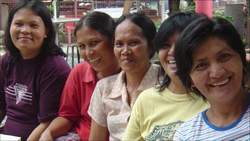
- Many have not dreamed of sending their children to a private school
Communicating this novel concept to parents is an educational campaign in itself. It is work that requires dedication, innovation and imagination. But it is work that is has its own rewards.
“The Parent Enterprise Program is what makes CPF different from other high schools. In other schools, they don’t care about the situation of the parents as long as the tuition fees are paid.” - Emilia Fornillos, parent of two CPF students
The goal of the Parent Enterprise Program is job creation and/or enterprise development. We scan the community resources and the market demand, and then we try to match the two. In the process, we help augment income of the parents, enough for them to afford sending their child to a private school.
In the school in the agricultural community in Sta. Rosa, Nueva Ecija, some parents send their children to CPF by participating in the school’s hog-fattening program. The school provided them with two piglets. They took the responsibility to produce the feeds for the piglets. After four months, they sell the pigs and the income is paid for tuition fee. Raising two piglets is enough to pay the tuition fee for half a year; four piglets are needed to pay tuition fee for one year. According to a parent involved in this program, “it is better for me to raise pigs and pay the school through hog-fattening. It is more difficult for me to pay the school in cash. With the pigs, I am obligated to feed them three times a day; otherwise they make a big noise. With the school, I sometimes forget to pay the tuition fee and if I have the cash, I am tempted to spend it for another need.”

In a far-off barangay in Puerto Princesa City, Palawan, some parents pay by letting the school use their tourist bancas twice a month. The school identifies local tourists who want to tour Honda Bay, swim in the beaches in the islands, snorkel, and enjoy a picnic lunch. Local tourists are only too happy to avail of the tour because the tour price offered by the school (P 200.00/person) is much lower than that offered by the hotel and travel agencies (P 1,000/person). The latter tour is availed of by domestic tourists from other islands and foreign tourists, leaving a big number of the local population unable to visit these islands because of its prohibitive price.
CPF also accepts payment in kind. This may be in the form of fish in Palawan, mangoes or rice in Nueva Ecija or cross-stitched Christmas decors in Montalban/San Mateo. These products are sold by the school to consumers.
Some parents pay through their services. In Banaba, San Mateo, four parents rotate as school guards. Fifty days acting as guard pay for the year’s tuition fee. Mobilizing parents to act as guards is not only a way of making them pay for the tuition fee. The parents exhibit heartfelt concern and dedication that are invaluable for the school’s safety and security.
Other parents participate in the school’s canteen program. They do the cooking, marketing, delivery of food, or act as food crew. They underwent training in food handling and food service to qualify for the work, earning a certificate in the process.
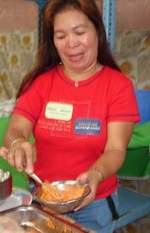
- Changing the nutritional patterns
The work of identifying jobs that parents can do is just beginning. Every time we hear of companies needing welders, carpenters, brick-layers, of hotels needing cleaners, or restaurants needing food servers, we jump at the opportunity. We open our eyes and ears to job possibilities. We are also organizing a job fair in school for parents to find their fit.
Others may argue that job creation and enterprise development are outside the realm of the school concerns. I want to repeat that while we do not diminish the importance of the responsibility of the school to provide education to the students, we are of the opinion that it is part of our responsibility to see to that the economically disadvantaged would have a fair chance of entering the school which we set up specifically with them in mind. What is the use aiming to cater to the economically disadvantaged if they could never afford to put their children through our school?
I have been talking of our school and our parents as resource. Now we go to the youth as resource as well as consumer of the school’s services.
Although the Center for Positive Futures caters to the economically disadvantaged, we hope to give them the best education as is possible with the resources available to us. This is because we believe that all children deserve the best kind of education. This is an integral part of the responsibilities we assume as educators and as social development practitioners. Towards this, there shall only be 30 students to a classroom. This is so that teachers can effectively address the needs of the students in the class. Also, in a smaller class size, students can absorb the presentation and the discussions better. With fewer students per class to manage, teachers would be able to innovate on teachers’ strategies that would challenge the creativity and imagination of the students. On the other hand, students would benefit by being treated as individuals with special skills and talents.
We subscribe to the notion of multiple intelligences as proposed by Dr. Howard Gardner. The eight different intelligences “account for a broader range of human potential in children and adults. These intelligences are:
- linguistic intelligence (‘word smart’) - logical-mathematical intelligence (‘number/reasoning smart’) - spatial intelligence (‘picture smart’) - bodily-kinesthetic intelligence (‘body smart’) - musical intelligence (‘music smart’) - interpersonal intelligence (‘people smart’) - intrapersonal intelligence (‘self smart’) - naturalist intelligence (‘nature smart’)” (Armstrong, 1998)
In CPF, we try to identify the different intelligences of the students and develop these. We provide spaces and venues by which sports, musical, artistic and creative inclinations can be developed in and outside the classroom. Students whose intelligences are recognized and who are respected as individuals develop greater self-confidence and self-worth. Thus, they become better learners.
Students should be treated as partners in the learning process. It is not only the teacher but the student as well who should take responsibility in learning. “Teacher is there only to teach the principles of the basic skills. Afterwards, the pupil must make use of other sources of learning, namely, observations, reflections on these observations, experimentation with phenomena through the use of all available materials and experience. Imposed teacher authority results in only two things – obedience or disobedience, neither of which can solve tomorrow’s problems.” (Ventenilla-Hamada, 1987)
The school is only one partner in the child’s education because education is the responsibility of several institutions in society. Sure, a school is a center for learning. But the family and other social institutions should also stand up to their responsibilities in educating the young.
CPF subscribes to a strong school and home partnership with the goal of promoting the holistic education of the students. A healthy home and school relationship is developed so that parents and teachers can be partners in education. In a home setting where day-to-day survival may be a concern of many families, we encourage families to support the child’s education by giving time to read with and check on her/his learning development. We struggle with orienting them on multiple intelligences because many parents only look at the “academic standing” of their children, overlooking their overall achievements.
Teachers, young as they are, are also challenged to be sensitive to the home environment. They learn to communicate with parents beyond the traditional teacher-parent relationship limited to “academic standing”. They probe what the conditions at home are, how the child was and is reared, how parents or guardians support the student financially and emotionally. Our teachers are developing into community workers as well.
With almost one-fifth of our students coming from OFW families with one or more absentee parents, providing socio-emotional support to these children becomes a big challenge. Socio-emotional support is a necessity in today’s education agenda also to counter the negative effects of gross commercialism such as that which glamorizes drinking and smoking, cell phones, junk food, violent online video games and the like.
Although we are raising the questions and concerns on the problems posed by absentee parents and gross commercialism, we do not claim to know the answers nor are we doing enough at the moment. There is much work to do to address these questions and concerns. Raising the issues is only the first step in searching for answers and endless possibilities.
Vocational-Technical Skills Training
Recognizing that the students we seek to serve hardly have means to send their children through college, we have been developing a vocational-technical curriculum to equip them with technical skills, work ethic and life skills. Although our practice is far from perfect, we have started vocational-technical skills training in the fields of home and community health care, information technology, food technology, and enterprise development.
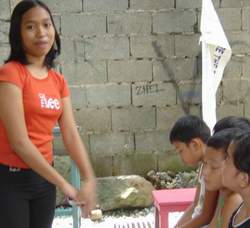
- Vocational Technical Courses
We hope to partner with post-secondary technical vocational schools with commitments to place their graduates in jobs after graduation for the benefit of our graduates. We also hope to partner with enterprises and companies toward placing our students as trainees or part-time workers after graduation. We hope to assist in developing community enterprises like home and community care-giving services that will eventually be phased over to entrepreneurs. We still have a lot of work to do in this regard but the vision is there. We know that to succeed as an educational institution, we should also concern ourselves with how our graduates develop productive careers and how they fare as responsible family members and community citizens.
A school is not a structure unto itself. It should be part of the life of the community. The community should put its stamp on the school, as the school should do likewise on the community. The community should challenge the school to be responsive to community needs, as the school should allow the community to positively influence its school programs. There should be integration and interactivity.
In Banaba, San Mateo, the school adopts a sister section in the public elementary school. Every year, a program is developed to link the two sets of students. These programs included sharing vermi-culture technology, teaching arts and crafts, organizing a tree nursery or conducting school plays in connection with protecting the environment. It also linked with the barangay or the local government council in providing safety personnel for schoolchildren crossing the main street.
 The school also has strong linkages with a community NGO called Buklod Tao Foundation, which is engaged in environmental protection and disaster management.
It is this NGO that guides the school through its Zero Waste Management Program that is only in its initial stage of implementation. The NGO lets the school use and develop its community tree nursery. It also guided the school in its tree-planting program. These two entities together organized a Girl Children’s Day in 2004 that resulted in the formation of a youth organization called the Buklod ng Kabataang Kababaihan sa Banaba.
The school also has strong linkages with a community NGO called Buklod Tao Foundation, which is engaged in environmental protection and disaster management.
It is this NGO that guides the school through its Zero Waste Management Program that is only in its initial stage of implementation. The NGO lets the school use and develop its community tree nursery. It also guided the school in its tree-planting program. These two entities together organized a Girl Children’s Day in 2004 that resulted in the formation of a youth organization called the Buklod ng Kabataang Kababaihan sa Banaba.
Together with the Community of Learners’ Foundation (a school based in Quezon City), the Buklod Tao Foundation and the school organized a one-day Peace Camp for children last December 2005.
In Puerto Princesa, Palawan, the school choir sings in the local Church once a week. The school flute quartet is being invited by the Department of Education every now and then to perform in city occasions. The school is always a participant in the monthly activity programs of the barangay. And during the city’s big tree-planting day last June, the students and teachers were there to plant a tree and “save the earth”.
There are endless possibilities for community networking. Hiatt-Michael says “schools serve as a hub for services to children, youth and families. The school serves as a natural center for these partnerships because children are required to be there for academic development. The school staff will experience many exciting and rewarding challenges throughout the process to connect the school to the community. The transformation of a community school, similar to other reforms, requires dedication and perseverance. Some moments may seem overwhelming... However, the vibrant throb of life in the community school, a school whose meaning and purpose move beyond academics to child and family well being, invigorates administrators, faculty and staff. The end is worth overcoming bureaucracy, politics, and funding challenges.” (Hiatt-Michael, 2003)
The following diagram shows the varied networking possibilities:
| SCHOOLS => | |||||||
| Business and Industry | Health Services | Safety and Security | Social Services | Educational Institutions | Faith-based Institutions | Cultural and Museums | Legal Services |
Hiatt-Michael, 2003
Education is a Social Development Responsibility
“The full potential of knowledge and know-how is realized only through sharing them, and through using them in the service of solidarity and the culture of peace.” - one of the guiding principles for the Charter for Human Responsibilities
Providing education is a big responsibility to the children, their parents, the community and society in general. It is a task that we at the Center for Positive Futures take seriously because it is both the present and the future lives of the students and their families that are involved.
But it is not the only responsibility we want to assume as an institution. Beyond being education providers, we consider ourselves as social development workers. We look at education as an entry point to community development interventions, working hand-in-hand with other community institutions like NGOs, the barangays (local government councils), the Church, the public school system, and other organizations.
We know that education is a powerful medium that has the potential to affect the health, livelihood, security, and culture of the students, their parents and the community around us. There is no other way but for school institutions to be involved in the bigger context, and to take responsibilities beyond academic development.
The responsibilities may be daunting but the possibilities are endless.
![]() Alliance for a Responsible, Plural and United World, Charter for Human Responsibilities, 2001.
Alliance for a Responsible, Plural and United World, Charter for Human Responsibilities, 2001.
![]() Armstrong, Thomas (1998). Multiple Intelligences. www.thomasarmstrong.com/multiple_in...
Armstrong, Thomas (1998). Multiple Intelligences. www.thomasarmstrong.com/multiple_in...
![]() Hiatt-Micheal, Diana B. (2003). Promising Practices to Connect Schools with the Community. USA: Information Age Publishing, Inc..
Hiatt-Micheal, Diana B. (2003). Promising Practices to Connect Schools with the Community. USA: Information Age Publishing, Inc..
![]() Ventilla-Hamada, Margarita (1987). School Myth Takes. Quezon City: New Day Publishers.
Ventilla-Hamada, Margarita (1987). School Myth Takes. Quezon City: New Day Publishers.
[1] P 52.00 = $ 1.00
[2] A school with pre-school to college located in E. Rodriguez, Quezon City now celebrating its 75th year as an educational institution; run by the SFIC sisters, this school has been providing assistance to CPF since inception
[3] Jose Abad Santos Memorial School located in E. delos Avenue, Quezon City


